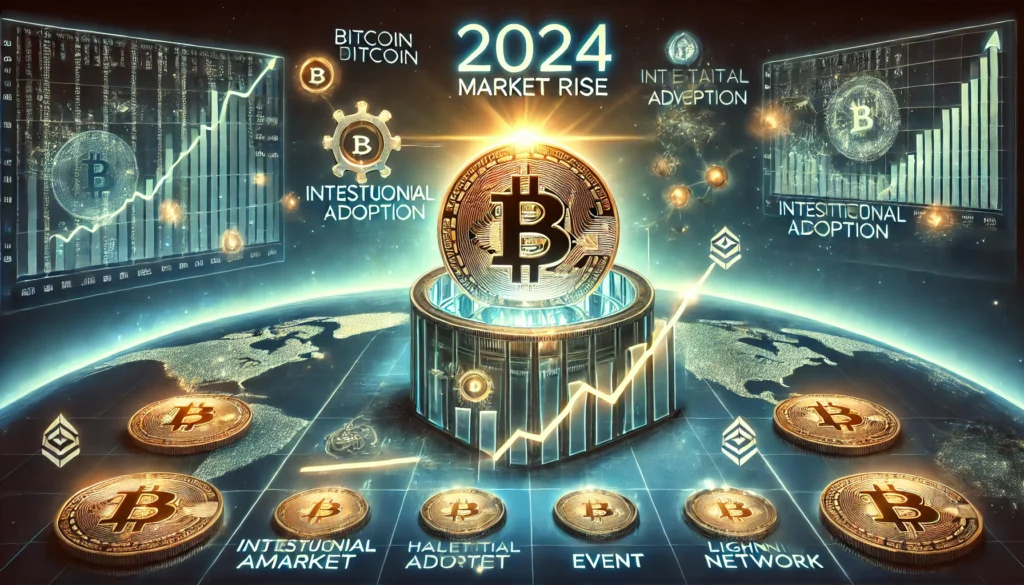
Introduction
Bitcoin, the pioneer of cryptocurrencies, continues to capture global attention as it experiences a remarkable resurgence in 2024. With its price climbing and adoption expanding, many are curious about the factors fueling this growth. This article delves into the key drivers behind Bitcoin’s market performance in 2024, examining macroeconomic trends, technological developments, and growing adoption.
1. Macroeconomic Factors Boosting Bitcoin
a) Inflation and Monetary Policy
As inflation persists in many economies, Bitcoin’s role as a hedge against fiat currency devaluation has gained prominence. Central banks, including the Federal Reserve, have maintained tight monetary policies, pushing investors to seek alternative stores of value.
b) Geopolitical Uncertainty
Global tensions and conflicts have driven demand for decentralized assets like Bitcoin, which are immune to government control and currency manipulation. Investors view Bitcoin as a safe haven during periods of instability.
c) Institutional Investment
The entry of institutional investors continues to bolster Bitcoin’s legitimacy. Major financial institutions, such as BlackRock and Fidelity, have expanded their Bitcoin offerings, including spot ETFs and custody services, driving significant capital into the market.
2. Technological Advancements and Network Developments
a) Lightning Network Expansion
Bitcoin’s Lightning Network, a second-layer scaling solution, has seen widespread adoption in 2024. Its ability to facilitate fast and low-cost transactions has made Bitcoin more practical for everyday use, particularly in emerging markets.
b) Taproot Adoption
The activation of the Taproot upgrade has enhanced Bitcoin’s privacy, scalability, and smart contract capabilities. These improvements attract developers and businesses to build applications on the Bitcoin network.
c) Renewable Energy Integration
Bitcoin mining’s transition toward renewable energy sources has mitigated environmental criticisms, improving public perception and attracting eco-conscious investors.
3. Growing Adoption Across Sectors
a) Retail and E-commerce
An increasing number of retailers are accepting Bitcoin as payment, driven by demand from tech-savvy consumers. Platforms like Shopify and PayPal have integrated Bitcoin payment options, further normalizing its use in commerce.
b) Governments and Central Banks
Countries like El Salvador and others in Latin America have adopted Bitcoin for national reserves and public projects. Additionally, central banks are exploring Bitcoin-backed financial instruments to complement CBDCs (Central Bank Digital Currencies).
c) Decentralized Finance (DeFi)
Bitcoin is gaining traction in the DeFi space through tokenized versions like Wrapped Bitcoin (WBTC). These innovations allow Bitcoin to participate in lending, borrowing, and liquidity provision on Ethereum-based platforms.
4. Market Dynamics and Price Trends
a) Limited Supply
Bitcoin’s capped supply of 21 million coins continues to drive its scarcity value. With over 19 million coins already mined, the approaching supply ceiling amplifies its appeal as “digital gold.”
b) Halving Anticipation
The 2024 Bitcoin halving event, expected to occur in April, will reduce block rewards from 6.25 BTC to 3.125 BTC. Historically, halving events have preceded significant price rallies due to supply constraints.
c) Increased Liquidity
Bitcoin’s market liquidity has improved with the introduction of regulated trading platforms and the approval of spot Bitcoin ETFs in key markets like the U.S. and Europe.
5. Challenges and Risks
a) Regulatory Scrutiny
Despite its growth, Bitcoin faces heightened regulatory oversight, particularly in the U.S. and Europe. Governments are tightening anti-money laundering (AML) and know-your-customer (KYC) requirements for crypto transactions.
b) Market Volatility
Bitcoin remains highly volatile, with significant price swings driven by macroeconomic events and market sentiment.
c) Competition
Rival cryptocurrencies, such as Ethereum and Solana, continue to innovate, potentially diverting investor interest and capital.
6. Expert Predictions for 2024
a) Price Forecasts
Analysts predict that Bitcoin’s price could reach new all-time highs in 2024, with estimates ranging between $100,000 and $150,000, depending on macroeconomic conditions and adoption rates.
b) Adoption Metrics
Metrics such as wallet addresses, transaction volumes, and Lightning Network usage indicate sustained growth in Bitcoin adoption.
c) Institutional Dominance
Experts anticipate that institutional investors will account for a larger share of Bitcoin’s trading volume, stabilizing the market and enhancing its credibility.
Conclusion
Bitcoin’s rise in 2024 is driven by a confluence of factors, including macroeconomic trends, technological advancements, and expanding adoption across sectors. While challenges like regulatory scrutiny and market volatility persist, Bitcoin’s resilience and innovation continue to position it as a leading asset in the evolving financial landscape. As adoption grows and the halving event approaches, Bitcoin’s role as a store of value and medium of exchange is likely to solidify further.
Relevant Resources
- Bitcoin.org: Official Bitcoin resources and updates.
- CoinDesk: Market news and analysis on Bitcoin.
- Glassnode: On-chain data and metrics for Bitcoin and other cryptocurrencies.